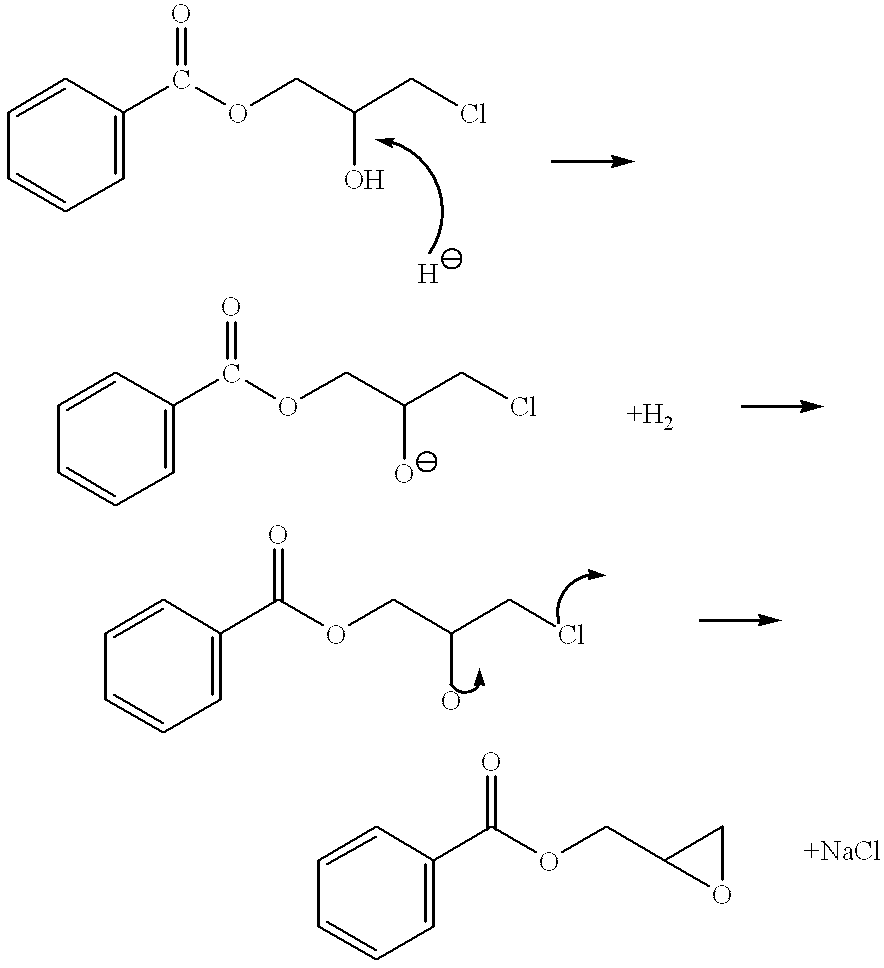Process for the elimination of materials containing hydrolyzable halides and other high molecular weight materials from epihalohydrin derived epoxy resins
a technology of epoxy resin and hydrolyzable halides, which is applied in the field of process for eliminating hydrolyzable halides and other high molecular weight materials from epihalohydrin derived epoxy resins, can solve the problems of reducing process efficiency, affecting epoxy performance, and affecting the performance of epoxy, so as to achieve high volume
- Summary
- Abstract
- Description
- Claims
- Application Information
AI Technical Summary
Benefits of technology
Problems solved by technology
Method used
Image
Examples
example 1
In a 1 liter three-neck round bottom flask, equipped with a mechanical stirrer, nitrogen inlet, and temperature probe, was added 500 grams of EPON.TM. Resin 828 (689 ppm hydrolyzable chloride), available from Shell Chemical Company, Houston, Texas. This mixture was heated to about 70.degree. C. and a premix of 1.5 grams of 85 percent potassium hydroxide in 1.5 grams of water was added. The resulting mixture was heated for about 4 hours and then dry ice was added and the mixing continued for about 30 minutes. This mixture was then cooled to room temperature. This gave a crude product which was distilled on a rolled film evaporator (model number KDL4, available from UIC Inc., Joliet, Ill.) at about 185.degree. C. at about 0.001 mm vacuum to give 224 grams of clear colorless material.
The test method used to determine the hydrolyzable chloride content in epoxy resins utilizes ion chromatography and is based on ASTM D 1726-90. The test procedure was as follows: A boiled-out (18 Mohm wate...
example 2
A sample of EPON.TM. Resin 862 (available from Shell Chemical Company) was distilled on a rolled film evaporator (model number KDL4) at about 170.degree. C. and about 0.001 mm vacuum. 354 grams of distillate and 178 grams of residue were obtained. The distillate was kept under a nitrogen atmosphere and transferred to a flask equipped with a mechanical stirrer, nitrogen inlet, and temperature probe. 0.56 grams of 60 percent sodium hydride in mineral oil was added to the flask and the mixture was heated to about 80.degree. C. at which point there was a slow evolution of hydrogen gas. The temperature was increased to about 100.degree. C. and the mixture was held at that temperature until no more gas evolution was detected (about two hours). The reaction mixture was cooled to about 70.degree. C. and dry ice added followed by 0.4 milliliters of water. More dry ice was added and the mixture cooled to room temperature. The crude product was distilled on a rolled film evaporator at about 17...
example 3
To 252 grams of distilled EPON.TM. Resin 828 (available from Shell Chemical Company) was added 15 milliliters of 1 M potassium t-butoxide in THF. The mixture was heated to about 30.degree. C. and stirred at that temperature for about 4 hours. After the addition of dry ice, the crude product was distilled on a rolled film evaporator (model number KDL4) at about 190.degree. C. and about 0.001 mm vacuum to give 157 grams of clear product. The concentration of hydrolyzable chloride was <1 ppm using the analysis method disclosed in Example 1. Using the analysis method of Example 1, the epoxide equivalent weight was 173 (theoretical value is 170).
PUM
| Property | Measurement | Unit |
|---|---|---|
| temperature | aaaaa | aaaaa |
| weight | aaaaa | aaaaa |
| weight | aaaaa | aaaaa |
Abstract
Description
Claims
Application Information
 Login to View More
Login to View More - R&D
- Intellectual Property
- Life Sciences
- Materials
- Tech Scout
- Unparalleled Data Quality
- Higher Quality Content
- 60% Fewer Hallucinations
Browse by: Latest US Patents, China's latest patents, Technical Efficacy Thesaurus, Application Domain, Technology Topic, Popular Technical Reports.
© 2025 PatSnap. All rights reserved.Legal|Privacy policy|Modern Slavery Act Transparency Statement|Sitemap|About US| Contact US: help@patsnap.com



